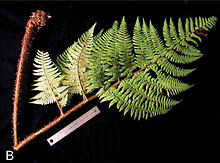Dryopteris macropholis
| Dryopteris macropholis | ||||||||||||
|---|---|---|---|---|---|---|---|---|---|---|---|---|

Dryopteris macropholis |
||||||||||||
| Systematics | ||||||||||||
|
||||||||||||
| Scientific name | ||||||||||||
| Dryopteris macropholis | ||||||||||||
| Lorence & WLWagner |
Dryopteris macropholis is a plant from the genus of dryopteris ( Dryopteris ) within the family of dryopteridaceae (Dryopteridaceae). She is endemic to the southern Pacific Ocean nearby Marquesas ago Islands.
description
Dryopteris macropholis grows as a fern . It forms an almost upright, 20 to 25 centimeter long rhizome , which is densely covered with scales and without the scales is between 5 and 7 centimeters thick. With scales, the rhizome becomes up to 15 centimeters thick. The thin and uniformly light brown, reddish brown to dark brown scales on the rhizome and on the base of the fern fronds are approximately elongated-elliptical to linear-lanceolate with a length of 1 to 8 centimeters and a width of 0.1 to 1.4 centimeters. They are curved like a sickle, twisted and have entire scale edges.
On each rhizome there are five to seven tuft-like, upright to arched fronds. The fronds have stalks that are 39 to 75 centimeters long and 0.4 to 0.6 centimeters thick and strong, which are reddish brown to straw-colored. They are furrowed on top and densely covered with two types of shiny light to dark to reddish brown scales. The twisted scales are about 2 centimeters long and about 0.3 centimeters wide and are linear-oblong to linear-lanceolate in shape and have entire to almost entire scale edges. The base of these scales is darker in color. You can also find bristle-like or hair-like scales. The base of older fronds is covered with dark scales.
The two- to three-pinnate or pinnate-cleft fronds are triangular-egg-shaped with a length of 50 to 100 centimeters and a width of 32 to 66 centimeters and consist of 11 to 20 pairs of pinnate leaves. Most of the time the lower half of the fronds is triple-pinnate while the upper half is usually double-pinnate. The straw-colored to light brown main axis of the fronds is densely covered with brown to dark brown, bristle-like scales, which can be around 0.9 centimeters long and 0.1 centimeters thick. In addition to these bristle-like scales, the main axes are also covered with glandular hair. The axis base of older fronds has dark brown scales. The thick, parchment-like leaflets are opposite to almost opposite arranged on the frond stalks. They become largest in the lower frond area and are there on a 0.3 to 0.6 centimeter long stalk, while the leaflets in the upper frond area are sessile. The leaflets consist of 11 to 16 pairs of leaflets , which are slightly larger on the downward-facing side of the leaflets than on the upward-facing side. The lowest leaflets are 20 to 33 centimeters long and 11 to 19 centimeters wide and have a pinnate tip. The leaflets of these leaflets are 7 to 10.5 centimeters long on the downward facing side and 4 to 8.5 centimeters long on the upward facing side. The upper side of the leaflets is glabrous while on the underside of the leaf axis there are isolated small brown scales while the tip is blunt to truncated. The edges of the leaflet are notched or cut off. The leaf nerve branches once or twice and is either barely noticeable or clearly visible on the underside of the leaf. Each fertile leaflet has one to four pairs of sori .
The thick brown sori are hairless and, together with the indusium, are 0.4 to 0.6 millimeters thick. The spores are dark brown in color.
Occurrence
The natural range of Dryopteris macropholis is on the Marquesas Islands in the southern Pacific . It includes the islands of Hiva Oa , Nuku Hiva , Tahuata , Ua Huka and Ua Pou .
Dryopteris macropholis thrives at altitudes of around 700 to 1150 meters. The species is found in mountainous regions, in moderately moist to damp forests and in bushland. The species is often associated with Alsophila tahitensis , Crossostylis biflora , Dicranopteris linearis , Fagraea berteroana , Ficus prolixa , Hernandia nukuhivensis , the linden-leaved marshmallow ( Hibiscus tiliaceus ), Metrosideros collhusumina , Vaccionia marquesum , Vaccionyllosere , Vaccionicum , Vaccionyllosere, and Weineros . as well as various representatives of the genera Cyrtandra , Freycinetia . Psychotria and Sphaeropteris .
Systematics
It was first described as Dryopteris macropholis in 2011 by David H. Lorence and Warren Lambert Wagner in PhytoKeys , number 4, page 15.
The closest related species is Dryopteris sweetorum , which is native to the island of Fatu Hiva .
swell
- David H. Lorence, Warren L. Wagner, Kenneth R. Wood, Alan R. Smith: New pteridophyte species and combinations from the Marquesas Islands, French Polynesia . In: PhytoKeys . No. 4 , 2011, ISSN 1314-2003 , p. 5-51 , doi : 10.3897 / phytokeys.4.1602 .
Individual evidence
- ↑ a b c d e f g David H. Lorence, Warren L. Wagner, Kenneth R. Wood, Alan R. Smith: New pteridophyte species and combinations from the Marquesas Islands, French Polynesia . In: PhytoKeys . No. 4 , 2011, ISSN 1314-2003 , p. 5-51 , doi : 10.3897 / phytokeys.4.1602 .
- ^ Dryopteris macropholis. In: The International Plant Names Index. www.ipni.org, accessed March 6, 2015 (English).

